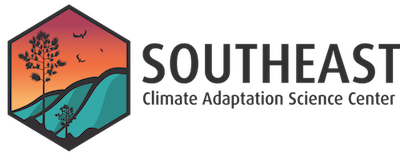Enie Hensel
Global Change Fellow Alumna | Department of Applied Ecology | North Carolina State University
Spring 2018 Global Change Fellow
Where are they now?
Enie is now working as a postdoctoral research associate at the Virginia Institute of Marine Sciences.
Statement of purpose:
I am an ecologist interested in coastal and nearshore food webs, exploring how ecosystems are connected through consumers like fish. Our coasts harbor valuable commercial fisheries and protect us from storms but are under threat from human actions that affect both the bottom and top of coastal food webs. My current research aims to understand how the loss of predatory fishes and habitat complexity alters nearshore ecosystem function using field experiments and large-scale surveys. As I progress in my scientific career, I want to apply my research towards coastal resource sustainability, education, and conservation.
Description of research:
Coastal human populations are intimately connected with their surrounding environment as they are dependent on the services they provide and yet, coastal and nearshore ecosystems are threatened by multiple stressors worldwide. My dissertation focuses on how human impacts including eutrophication, habitat degradation, and overharvesting change Caribbean coral and seagrass food web structure and ecosystem function, e.g., changes in local fish communities and nutrient uptake. My research is conducted off the shorelines of Great Abaco Island, The Bahamas where conservation managers are currently using coral restoration (increase habitat structure) and stricter fishing regulations (protect top predators) to restore food webs, maintain ecosystem function, and maximize fish abundance. One focus of my dissertation has explored how reef restoration and predator protection together affect fish communities. In a field experiment, I found that both reef complexity and predator presence (the endangered Nassau grouper) had an equal and positive effect on the reef community, increasing total fish biomass and the number of fish species. Thus, to maintain a healthy, productive reef system we need to manage stressors that affect both the bottom and top of reef food webs.
To date, I have collaborated with several NGOs incorporating my research into educational outreach programs as well as using my findings to inform conservation management. Science communication is an important and integral part of my current research program and career goals, and the SE CSC Global Change Fellows program provides a valuable opportunity to further integrate these components into my research. My research aligns with the SE CSC’s Science Plan Theme 5: Impacts of Climate Change on Coastal and Nearshore Marine Environments, Task 3- Describe how estuaries and marine resources are affected by increased temperature, sea-level rise, changes in runoff patterns to the coast, ocean acidification, and changes in the destructive potential of tropical storms and Science Plan Theme 4: Ecological Research and Modeling, Task 3-Conduct laboratory and field experiments to document organismal responses to climate change and Task 4- Identify new or altered species interactions that are likely to have a disproportionate impact on community structure and ecosystem function.
Publications:
Allgeier, J. E., Andskog, M., Hensel, E., Appaldo, R., Layman, C. A., D. W. Kemp. 2020. Re-wiring coral: anthropogenic nutrients shunt coral-symbiont nutrient and energy pathways through algal symbiont. Global Change Biology 26(10), 5588-5601.
Hensel, E., Allgeier, J. A., and C. A. Layman. 2019. Effects of predator presence and habitat complexity on reef fish communities in The Bahamas. Marine Biology 166 (10): 136.
Hensel, E., Wenclawski, S.*, and C. A. Layman. 2018. Using a small, consumer-grade drone to identify and count marine megafauna in shallow habitats. Latin American Journal of Aquatic Research. 46(5).
Allgeier, J. A., Layman, C. A., Montana, C. G., Hensel, E., Appaldo, R., and A. D. Rosemond. 2018. Anthropogenic versus fish – derived nutrient effects on seagrass community structure and function. Ecology. 99(8): 1792 – 1801.
Archer, S. K., Hensel, E., and C. A. Layman. 2018. Ambient nutrient availability drives the outcome of an interaction between a sponge (Halichondria melanadocia) and a seagrass (Thalassia testudinum). Journal of Experimental Marine Biology and Ecology. 503: 86 – 91.
Contact Information:
Email: eniehensel@gmail.com
Website: eniehensel.com
